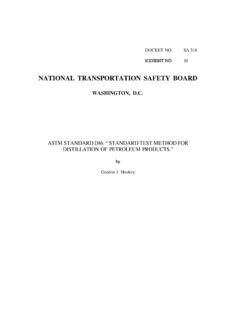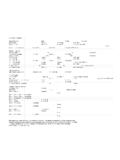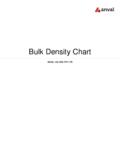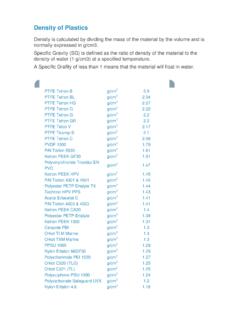Transcription of NATIONAL TRANSPORTATION SAFETY BOARD
1 DOCKET 516 EXHIBIT NO. 8 HNATIONAL TRANSPORTATION SAFETY BOARDWASHINGTON, STANDARD D4052: STANDARD TEST METHOD FORDENSITY AND RELATIVE density OF LIQUIDS BY DIGITALDENSITY METER. Gordon J. HookeyIW I>0 /\.r,,,,1, Designation: 365/84(86) II, *I 1*.1,,11$ Standard Test Method for density and Relative density of Liquids by Digital density Meter This standard is issued under the fixed designation D 4052; the number immediately following the designation indicates the year of original adoption or, in the case of revision, the year of last revision. A number in parentheses indicates the year of last reapproval. A superscript epsilon (c) indicates an editorial change since the last revision or reapproval. This method was adopted as a joint ASTUIP standard in 1984 1. Scope This test method covers the determination of the den- sity or relative density of petroleum distillates and viscous oils that can be handled in a normal fashion as liquids at test temperatures between 15 and 35 C.
2 Its application is re- stricted to liquids with vapor pressures below 600 mm Hg (80 kPa) and viscosities below about 15 000 cSt (mm2/s) at the temperature of test. This test method should not be applied to samples so dark in color that the absence of air bubbles in the sample cell cannot be established with certainty. For the determina- tion of density in crude oil samples use Test Method D 5002. The accepted units of measure for density are grams per millilitre or kilograms per cubic metre. This standard does not purport to address all of the SAFETY , concerns, if any, associated with its use. It is the responsibility of the user of this standard to establish appro- priate SAFETY and health practices and determine the applica- bility. of regulatory limitations prior to use. For specific hazard statements, see Notes 1 and 2.
3 2. Referenced Document ASTM Standard: D 1 193 Specification for Reagent Water2 D 1250 Guide for Petroleum Measurement Tables3 D4057 Practice for Manual Sampling of Petroleum and Petroleum Products4 D 4 177 Practice for Automatic Sampling of Petroleum and Petroleum Products4 D4377 Test Method for Water in Crude Oils by Potentiometric Karl Fischer Titration4 D5002 Test Method for density and Relative density of Crude Oils by Digital density Analyzer5 3. Terminology Definitions: This test method is under the jurisdiction of ASTM Committee D-2 on Petroleum Products and Lubricants and is the direct responsibility of Subcom- mittee on Hydrocarbon Analysis. Current edition approved Jan. 15, 1995. Published March 1995. Originally published as D 4052 - 8 I. Last previous edition D 4052 - 91.
4 2 .-innrrol Book oJASTM Standards, Vol 3 .-lnnunl Book oJASTM Siandards, Vol 4 .-lnnual Book of ASTM Standards, 5 Annual Book o/ASTM Slandards, Vol Designation: D 4052 - 95 An Amencan NATIONAL St- density -mass per unit volume at a specified tern-- perature. relative density -the ratio of the density of a mate- rial at a stated temperature to the density of water at a stated temperature. 4. Summary of Test Method A small volume (approximately mL) of liquid sample is introduced into an oscillating sample tube and the change in oscillating frequency caused by the change in the mass of the tube is used in conjunction with calibration data to determine the density of the sample. 5. Significance and Use density is a fundamental physical property that can be used in conjunction with other properties to characterize both the light and heavy fractions of petroleum and petro- leum products.
5 Determination of the density or relative density of petroleum and its products is necessary for the conversion of measured volumes to volumes at the standard temperature of 15 C. 6. Apparatus Digital density Analyzer-A digital analyzer con- sisting of a U-shaped, oscillating sample tube and a system for electronic excitation, frequency counting, and display. The analyzer must accommodate the accurate measurement of the sample temperature during measurement or must control the sample temperature as described in The instrument shall be capable of meeting the precision require- ments described in this test method. Circulating Constant-Temperature Bath, (optional) capable of maintaining the temperature of the circulating liquid constant to _+ C in the desired range. Temperature control can be maintained as part of the density analyzer instrument package.
6 Syringes, at least 2 mL in volume with a tip or an adapter tip that will tit the opening of the oscillating tube. Flow-Through or Pressure Adapter, for use as an alternative means of introducing the sample into the density analyzer either by a pump or by vacuum. Thermometer, calibrated and graduated to C, and a thermometer holder that can be attached to the instrument for setting and observing the test temperature. In calibrating the thermometer, the ice point and bore connections should be estimated to the nearest 7. Reagents and Materials Purity of Reagents-Reagent grade chemicals shall be used in all tests. Unless otherwise indicated, it is intended that all reagents shall conform to the specifications of the Committee on Analytical Reagents of the American Chem- ical Society, where such specifications are Other grades may be used, provided it is first ascertained that the reagent is of sufficiently high purity to permit its use without lessening the accuracy of the determination.
7 Purity of Water-Unless otherwise indicated, refer- ences to water shall be understood to mean reagent water as defined by Type II of Specification D 1193. Water, redistilled, freshly boiled and cooled reagent water for use as a primary calibration standard. Petroleum Naphtha, for flushing viscous petroleum samples from the sample tube. NOTE l-Extremely flammable. Acetone, for flushing and drying the sample tube. NOTE 2: Warning-Extremely flammable. Dry Air-for blowing the oscillator tube. 8. Sampling, Test Specimens, and Test Units Sampling is defined as all the steps required to obtain an aliquot of the contents of any pipe, tank, or other system, and to place the sample into the laboratory test container. The laboratory test container and sample volume shall be of sufficient capacity to mix the sample and obtain a homoge- neous sample for analysis.
8 Laboratory Sample-Use only representative samples obtained as specified in Practices D 4057 or D 4177 for this test method. Test Specimen-A portion or volume of sample obtained from the laboratory sample and delivered to the density analyzer sample tube. The test specimen is obtained as follows: Mix the sample if required to homogenize. The mixing may be accomplished as described in Practice D 4 177 (Section 11) or Test Method D 4377 (A. 1). Mixing at room temperature in an open container can result in the loss of volatile material, so mixing in closed, pressurized containers or at sub-ambient temperatures is recommended. Draw the test specimen from a properly mixed lab- oratory sample using an appropriate syringe. Alternatively, if the proper density analyzer attachments and connecting tubes are used then the test specimen can be delivered directly to the analyzer s sample tube from the mixing container.
9 9. Preparation of Apparatus Set up the density analyzer and constant temperature 6 Reagent Chemicals. American Chemical Sociery Specilications, American Chemical Society, Washington, DC. For suggestions on the testing of reagents not hd by the A merican Chemical Society, see Analar Standards for Laboratory Chemicols. BDH Ltd., Poole, Dorset, , and the United Srafes Pharmacopeia and NATIONAL Formulary, Pharmaceutical Convention, Inc. (USPC), Rodhk, MD. Suitable solvent naphthas are marketed under various designations such as *Petroleum Ether, iz Ligroine, or Precipitation Naphtha. bath following the manufacturer s instructions. Adjust the bath or internal temperature control so that the desired test temperature is established and maintained in the sample compartment of the analyzer.
10 Calibrate the instrument at the same temperature at which the density of the sample is to be measured. NOTE 3: Caution-Precise setting and control of the test temperature in the sample tube is extremely important. An error of 0. 1 C can result in a change in density of one in the fourth decimal. 10. Calibration of Apparatus Calibrate the instrument when first set up and whenever the test temperature is changed. Thereafter, con- duct calibration checks at weekly intervals during routine operation. Initial calibration, or calibration after a change in test temperature, necessitates calculation of the values of the constants A and B from the periods of oscillation (T) observed when the sample cell contains air, and redistilled, freshly boiled and cooled reagent water. Other calibrating materials such as n-nonane, n-tridecane, cyclohexane, and n-hexadecane (for high temperature applications) can also be used as appropriate.









